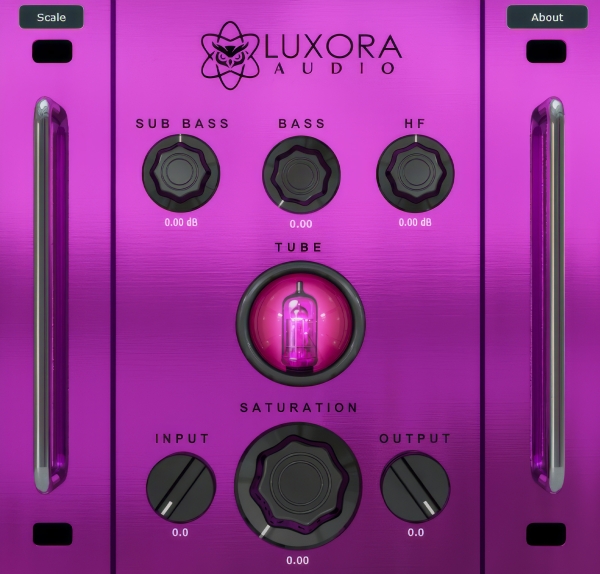Lux Sub-Bass (by Luxora Audio) — Deep low end, zero cost: a hands-on guide
If your mixes feel thin in the very bottom end or your 808s and bass guitars need more presence without getting muddy, Luxora Audio’s Lux Sub-Bass is one of the quickest, most musical tools you can try — and yes, it’s free. In a single, focused plugin the developer combines analog-style tube saturation, a low-end EQ, and high-resolution oversampling so you can add weight and character to sub frequencies without turning your mix into a swamp. You can grab the plugin directly from Luxora Audio’s site.
What is Lux Sub Bass?
Lux Sub-Bass is a free low-end enhancer aimed at producers, mixers and beatmakers who want richer sub frequencies for 808s, bass guitars, synths and drum buses. It uses an analog-modeled tube saturation algorithm (modeled on the 12AU7 family) and includes a dedicated EQ optimized for the sub range — all while keeping CPU usage reasonable thanks to careful oversampling. The plugin is available in VST3, AU and AAX formats for macOS and Windows.
Why is it useful?
-
Adds musical harmonics — Instead of only boosting LF energy with an EQ (which can make things boom and mask other elements), Lux Sub-Bass generates harmonics from a modeled tube stage, making bass feel louder and fuller on small speakers and in clubs without excessive low-end gain.
-
Quick workflow — The UI and control set are designed for speed: get more body with a single dial of saturation and then sculpt with the built-in EQ. That makes it ideal for fast sessions and for producers who want results with minimal tweaking.
-
Mix-friendly — Because the plugin focuses on adding harmonics and shaping rather than brute-force boosting, you can maintain headroom and clarity across the mix. This is especially helpful on drum buses and layered 808s.
Key features at a glance
-
Analog-modeled 12AU7 tube saturation for warm harmonic content.
-
Built-in EQ tailored to sub-bass and low-mid shaping.
-
High-resolution oversampling to avoid aliasing while saturating.
-
Formats: VST3, AU, AAX (Windows & macOS).
-
Low CPU footprint relative to the quality (though heavy oversampling or extreme settings can increase usage).
How to use Lux Sub-Bass — practical tips
Insert point: Put Lux Sub-Bass either directly on the bass instrument/track (808, bass DI, synth bass) or on a drum bus when you want extra weight on the low end of the kit. If you use it on the master, use it sparingly — it’s more of an instrument/bus tool.
Gain staging: Drive the input until the tube indicator shows activity, then back off the output so the plugin’s coloration is doing the perceived loudness work rather than gain. The tube indicator tells you when the modeled tube stage is contributing harmonics.
EQ use: Use the built-in EQ to tighten the sub region after adding saturation. Often a slight low-shelf or tuned bell will let the sub sit without smearing the low-mids. If you’re working with a bass guitar, try a narrow boost around the subfundamental and then a small cut in the low-mids to remove boxiness.
Parallel trick: For more control, send your bass to an aux with Lux Sub-Bass on it and blend parallel. That way you retain the original transient clarity while adding harmonic weight underneath.
Preset starting points: Start conservatively — 20–30% saturation and gentle EQ — then increase for genres that want more coloration (trap, certain EDM styles). For more natural music (jazz, acoustic), keep saturation subtle.
Download and installation
Luxora Audio offers Lux Sub-Bass as a free download on their website in multiple plugin formats. You can download it from Luxora’s official sub-bass product page. If the site requires a quick registration or an email to access the installer, that’s normal — a few third-party writeups have mentioned a short registration step before downloading.
Download spot (quick): Download Lux Sub-Bass from the official product page on Luxora Audio’s site.
(If you prefer reading community impressions first, sites like AudioLatry, KVR and Bedroom Producers Blog also covered the release and link to the official download.) (
Real-world examples
-
808s in modern trap: Instead of increasing the low-frequency fader by 3–6 dB (which can make a sub boomy), add harmonic saturation so your 808 reads stronger on club systems and phone speakers without redistributing energy.
-
Bass guitar in a rock mix: Give the bass a rounder, thicker core by lightly saturating the sub region and pulling a bit of low-mid mud with the plugin’s EQ.
-
Drum bus glue: A touch of sub saturation on the drum bus can glue kicks and low percussion together, making the groove feel heavier.
Many early reviewers praised Lux Sub-Bass for sounding musical and for how quickly it can fatten a low end without obvious artifacts. As always, use your ears and A/B comparisons (bypass on/off) to check that you’re enhancing rather than masking important mix detail.
Pros and cons
Pros
-
Free and available in industry formats.
-
Musical tube modeling tailored to the low end.
-
Simple, fast workflow for quick sessions.
Cons
-
Some users report extra CPU load when using oversampling + EQ at extreme settings. Keep an eye on load in large projects.
-
It adds color — which is usually good — but you may prefer linear tools in surgical mastering situations.
Final thoughts
For producers who want to add weight, warmth and perception of volume to their low end without resorting to large EQ boosts, Lux Sub-Bass is a high-value tool — especially because it’s free. It’s fast to dial in, compatible with major DAWs, and designed specifically for the task of sub-bass enhancement. Whether you’re polishing a mix, designing a heavy 808, or trying to make a synth bass translate better to small speakers, Lux Sub-Bass deserves a spot in the toolbox. Download it from Luxora Audio and try a few parallel and in-chain experiments to hear the difference.
